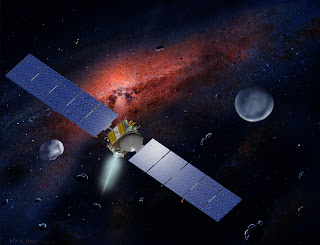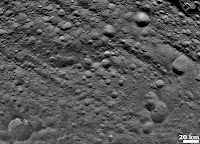 |
| Vesta : Image taken by Dawn Spacecraft |
Vesta, formally designated 4 Vesta, is one of the largest asteroids in the Solar System, with a mean diameter of about 525 kilometres (326 mi). It was discovered by Heinrich Wilhelm Olbers on 29 March 1807, and is named after Vesta, the virgin goddess of home and hearth from Roman mythology.
Vesta is the second-most-massive asteroid after the dwarf planet Ceres, and comprises an estimated 9% of the mass of the asteroid belt. The less-massive Pallas might have a larger volume, which would make Vesta third in overall size, but the precise dimensions of Pallas are not known. Vesta is the last remaining rocky protoplanet with a differentiated interior, of the kind that formed the terrestrial planets. It lost some 1% of its mass less than a billion years ago in a collision that left an enormous crater occupying much of its southern hemisphere. Debris from this event has fallen to Earth ashowardite–eucrite–diogenite (HED) meteorites, a rich source of information about the asteroid.
Vesta is the brightest asteroid visible from Earth. Its maximum distance from the Sun is slightly farther than the minimum distance of Ceres from the Sun, though its orbit lies entirely within the Cererian orbit.
 |
| Dawn Spacecraft : Artist's conception of Dawn, orbiting Vesta. |
NASA's Dawn spacecraft entered orbit around Vesta on 16 July 2011 for a one-year exploration, and what is known about Vesta will be refined and extended as data from Dawn is analyzed and published. Dawn left Vestan orbit on 5 September 2012.
Heinrich Olbers discovered Pallas in 1802, the year after the discovery of Ceres. He proposed that the two objects were the remnants of a destroyed planet. He sent a letter with his proposal to the English astronomer William Herschel, suggesting that a search near the locations where the orbits of Ceres and Pallas intersected might reveal more fragments. These orbital intersections were located in the constellations of Cetus and Virgo. Olbers commenced his search in 1802, and on 29 March 1807 he discovered Vesta in the constellation Virgo — a coincidence, as Ceres, Pallas, and Vesta are not fragments of a larger body. As the asteroid Juno had been discovered in 1804, this made Vesta the fourth object to be identified in the region that is now known as the asteroid belt. The discovery was announced in a letter addressed to German astronomer Johann H. Schröter dated 31 March. Because Olbers already had credit for discovering a planet, Pallas (at the time, the asteroids were considered to be planets), he gave the honor of naming his new discovery to German mathematician Carl Friedrich Gauss, whose orbital calculations had enabled astronomers to confirm the existence of Ceres, the first asteroid, and who had computed the orbit of the new planet in the remarkably short time of 10 hours. Gauss decided on the Roman virgin goddess of home and hearth,Vesta.
Vesta was the fourth asteroid to be discovered, hence the number 4 in its formal designation. The name Vesta, or national variants thereof, is in international use with two exceptions, Greece and China. In Greek the name adopted was the Hellenic equivalent of Vesta, Hestia (4 Εστία); in English, that name is used for 46 Hestia (Greeks use the name "Hestia" for both, with the asteroid numbers used for disambiguation). In Chinese, Vesta is called the 'hearth-god(dess) star', 灶神星 zàoshénxīng, in contrast to the goddess Vesta, who goes by her Latin name.
When Olbers discovered Vesta, Ceres, Pallas, and Juno were classified as planets and each had its own planetary symbol. Vesta was likewise classified as a planet, and along with its name, Gauss designed an appropriate planetary symbol, ⚶, the altar of the Vesta with its sacred fire. In Gauss's conception this was drawn  ; in its modern form it is
; in its modern form it is  .[note 1]
.[note 1]
 ; in its modern form it is
; in its modern form it is  .[note 1]
.[note 1]
After the discovery of Vesta, no further objects were discovered for 38 years, and the Solar System was thought to have eleven planets. However, in 1845 new asteroids started being discovered at a rapid pace, and by 1851 there were fifteen, each with its own symbol, in addition to the seven major planets. It soon became clear that it would be impractical to continue inventing new planetary symbols indefinitely, and some of the existing ones proved difficult to draw quickly. That year the problem was addressed by Benjamin Apthorp Gould, who suggested numbering asteroids in their order of discovery, and placing this number in a disk (circle) as the generic symbol of an asteroid. Thus the fourth asteroid, Vesta, acquired the generic symbol ④. This was soon coupled with the name into an official number–name designation, ④ Vesta, as the number of minor planets increased. By ca 1858, the circle had been simplified to parentheses, (4) and (4) Vesta, which was easier to typeset. Other punctuation such as 4) Vesta and 4, Vesta was also used, but had more or less completely died out by 1949. Today either (4) Vesta or more commonly 4 Vesta is used.
Vesta is the second-most-massive body in the asteroid belt, though only 28% as massive as Ceres. The surface area is approximately the same as that of Pakistan. Vesta orbits in the inner asteroid belt interior to the Kirkwood gap at 2.50 AU. It has a differentiated interior, and is similar to 2 Pallas in volume (to within uncertainty) but about 25% more massive.
Vesta's shape is relatively close to a gravitationally relaxed oblate spheroid, but the large concavity and protrusion at the pole combined with a mass less than 5×1020 kg precluded Vesta from automatically being considered a dwarf planet under International Astronomical Union (IAU) Resolution XXVI 5. Vesta may be listed as a dwarf planet in the future, if it is convincingly determined that its shape, other than the large impact basin at the southern pole, is due to hydrostatic equilibrium.
 |
| Surfaces of Vesta |
Its rotation is relatively fast for an asteroid (5.342 h) and prograde, with the north pole pointing in the direction of right ascension 20 h 32 min, declination +48° (in the constellation Cygnus) with an uncertainty of about 10°. This gives an axial tilt of 29°.
Temperatures on the surface have been estimated to lie between about −20 °C with the Sun overhead, dropping to about −190 °C at the winter pole. Typical daytime and nighttime temperatures are −60 °C and −130 °C, respectively. This estimate is for 6 May 1996, very close to perihelion, while details vary somewhat with the seasons. Prior to the arrival of the Dawn spacecraft, some Vestan surface features had already been resolved using the Hubble Space Telescope and ground-based telescopes
 |
| Craters of Vesta |
What does NASA says about VESTA ?
"We're seeing enormous mountains, valleys, hills, cliffs, troughs, ridges, craters of all sizes, and plains," says Chris Russell, Dawn principal investigator from UCLA. "Vesta is not a simple ball of rock. This is a world with a rich geochemical history. It has quite a story to tell!"
In fact, the asteroid is so complex that Russell and members of his team are calling it the "smallest terrestrial planet."
Vesta has an iron core, notes Russell, and its surface features indicate that the asteroid is "differentiated" like the terrestrial planets Earth, Mercury, Mars, and Venus.
Differentiation is what happens when the interior of an active planet gets hot enough to melt, separating its materials into layers. The light material floats to the top while the heavy elements, such as iron and nickel, sink to the center of the planet.
Researchers believe this process also happened to Vesta.
The story begins about 4.57 billion years ago, when the planets of the Solar System started forming from the primordial solar nebula. As Jupiter gathered itself together, its powerful gravity stirred up the material in the asteroid belt so objects there could no longer coalesce. Vesta was in the process of growing into a full-fledged planet when Jupiter interrupted the process.
Although Vesta’s growth was stunted, it is still differentiated like a true planet.
"We believe that the Solar System received an extra slug of radioactive aluminum and iron from a nearby supernova explosion at the time Vesta was forming," explains Russell. "These materials decay and give off heat. As the asteroid was gathering material up into a big ball of rock, it was also trapping the heat inside itself."
As Vesta’s core melted, lighter materials rose to the surface, forming volcanoes and mountains and lava flows.
 |
| Full Rotation of Vesta |
"We think Vesta had volcanoes and flowing lava at one time, although we've not yet found any ancient volcanoes there," says Russell. "We're still looking. Vesta's plains seem similar to Hawaii's surface, which is basaltic lava solidified after flowing onto the surface.
Vesta has so much in common with the terrestrial planets, should it be formally reclassified from "asteroid" to "dwarf planet"?
"That's up to the International Astronomical Union, but at least on the inside, Vesta is doing all the things a planet does."
**************************************
Melaka Planetarium Adventure Science Centre
Melaka Planetarium Adventure Science Centre

0 comments:
Post a Comment